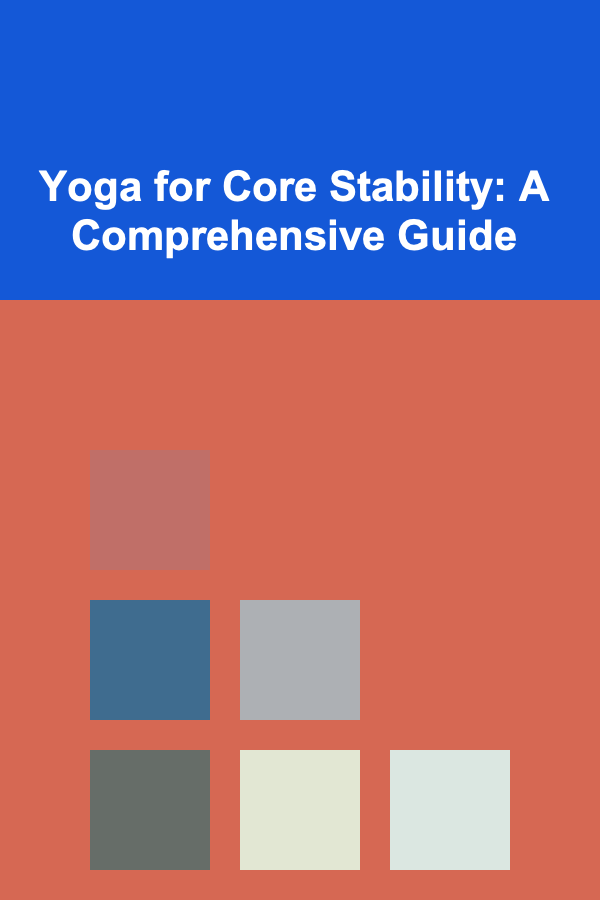
Yoga for Core Stability: A Comprehensive Guide
ebook include PDF & Audio bundle (Micro Guide)
$12.99$11.99
Limited Time Offer! Order within the next:

Introduction: Why Core Stability Matters
In the realm of physical fitness and overall well-being, core stability stands out as a cornerstone. It's more than just having washboard abs; it's about the strength and coordination of the muscles that stabilize your spine and pelvis. A strong and stable core acts as a foundation for all movements, supporting your posture, protecting your back, and improving athletic performance. A weak core can lead to a cascade of problems, including lower back pain, poor balance, increased risk of injury, and decreased efficiency in everyday activities.
Yoga, with its emphasis on mindful movement, breath control, and postural alignment, is an incredibly effective practice for cultivating core stability. Unlike traditional core exercises that often isolate individual muscles, yoga engages the entire core unit in a holistic and integrated way. It promotes a deeper understanding of your body and how to activate your core muscles correctly, leading to lasting improvements in strength, stability, and overall well-being.
This guide will explore how to effectively practice yoga for core stability. We will delve into the anatomy of the core, discuss key principles of core engagement, and provide a detailed sequence of yoga poses specifically designed to strengthen and stabilize your core. We will also address common mistakes and offer modifications to suit different levels of experience. This isn't just about getting a flatter stomach; it's about building a resilient and supportive foundation for a healthier and more active life.
Understanding the Anatomy of the Core
The "core" isn't just your abdominal muscles. It's a complex network of muscles that work together to stabilize your spine and pelvis. Understanding these muscles and their roles is crucial for effectively engaging them during your yoga practice.
- Transverse Abdominis (TVA): Often referred to as the "corset muscle," the TVA is the deepest abdominal muscle. Its primary function is to stabilize the spine by drawing the abdomen inward. Imagine gently pulling your navel towards your spine -- that's the TVA at work. Activating the TVA creates a hoop of stability around your lower back.
- Rectus Abdominis: This is the "six-pack" muscle. While it contributes to core strength, its primary function is spinal flexion (bending forward). Over-reliance on the rectus abdominis without engaging the deeper core muscles can lead to imbalances and back pain.
- Internal and External Obliques: These muscles are located on the sides of your abdomen and are responsible for spinal rotation and lateral flexion (bending sideways). They also play a vital role in core stabilization and preventing unwanted twisting movements.
- Multifidus: These small muscles run along the spine and are crucial for segmental spinal stability. They help to control and stabilize individual vertebrae, preventing excessive movement.
- Erector Spinae: These muscles run along the back of the spine and are responsible for spinal extension (bending backward). They work in conjunction with the abdominal muscles to maintain spinal stability.
- Diaphragm: The primary muscle of respiration, the diaphragm also plays a crucial role in core stability. During inhalation, the diaphragm descends, increasing intra-abdominal pressure, which helps to stabilize the spine.
- Pelvic Floor Muscles: These muscles form the base of the core and support the pelvic organs. They also contribute to core stability and control of bowel and bladder function.
These muscles don't work in isolation. They function as a coordinated unit to provide stability and support to your spine and pelvis. Effective core stability training involves engaging all of these muscles together, creating a strong and resilient core.
Key Principles of Core Engagement in Yoga
Engaging your core effectively in yoga requires more than just flexing your abdominal muscles. It's about cultivating a deep awareness of your body and learning to activate the right muscles in the right way. Here are some key principles to keep in mind:
- Breath Awareness: Your breath is your anchor. Consciously connecting to your breath helps you access your core muscles. Focus on breathing deeply into your abdomen, allowing your diaphragm to expand and contract fully. As you exhale, gently engage your TVA by drawing your navel towards your spine.
- Pelvic Tilt: Understanding pelvic tilt is essential for maintaining proper spinal alignment. An anterior pelvic tilt (arching the lower back) can put stress on the spine, while a posterior pelvic tilt (tucking the tailbone) can deactivate the core muscles. Aim for a neutral pelvic tilt, where your pelvis is balanced and your spine is in its natural curves.
- Mindful Engagement: Avoid gripping or over-activating your core muscles. Instead, focus on gentle and sustained engagement. Imagine drawing your lower ribs towards your hips, creating a sense of compression in your abdomen.
- Spinal Alignment: Maintaining proper spinal alignment is crucial for protecting your back and maximizing core engagement. Lengthen your spine from the crown of your head to your tailbone, creating space between your vertebrae.
- Integration: Engage your core in every pose, not just the ones that are traditionally considered "core work." By integrating core engagement into your entire practice, you'll build a stronger and more stable foundation for all movements.
- Progressive Overload: Start with simpler poses and gradually progress to more challenging variations as your core strength improves. Avoid pushing yourself too hard too soon, as this can lead to injury.
A Yoga Sequence for Core Stability
This sequence is designed to progressively strengthen and stabilize your core. Remember to listen to your body and modify the poses as needed. Hold each pose for 5-10 breaths, focusing on maintaining proper alignment and engaging your core muscles.
-
Mountain Pose (Tadasana):
Stand with your feet hip-width apart, grounding down through all four corners of your feet. Engage your quadriceps and draw your kneecaps up. Tilt your pelvis to neutral, lengthen your spine, and draw your shoulder blades down your back. Engage your core by gently drawing your navel towards your spine. Hold for 5-10 breaths.
-
Cat-Cow Pose (Marjaryasana to Bitilasana):
Start on your hands and knees, with your hands shoulder-width apart and your knees hip-width apart. Inhale and arch your back, dropping your belly towards the floor (Cow Pose). Exhale and round your back, tucking your tailbone and drawing your chin to your chest (Cat Pose). Continue flowing between these two poses for 5-10 breaths, coordinating your movement with your breath. This warms up the spine and helps to cultivate awareness of pelvic tilt.
-
Bird Dog Pose (Dandayamana Bharmanasana):
Start on your hands and knees. Engage your core and extend your right arm forward and your left leg back, keeping your spine in a straight line. Avoid arching your back or rotating your hips. Hold for 5 breaths, then return to the starting position and repeat on the other side. This pose strengthens the core and improves balance and coordination.
-
Plank Pose (Phalakasana):
Start on your hands and knees. Step your feet back, one at a time, until your body forms a straight line from your head to your heels. Engage your core by drawing your navel towards your spine and tucking your tailbone slightly. Avoid letting your hips sag or your shoulders hunch. Hold for as long as you can maintain good form, gradually increasing the duration as your strength improves. Plank pose is a foundational core strengthening exercise.
-
Side Plank (Vasisthasana):
From Plank Pose, shift your weight onto your right hand and rotate your body to the right, stacking your left foot on top of your right foot. Extend your left arm towards the ceiling. Engage your core to keep your body in a straight line. If this is too challenging, you can modify the pose by dropping your right knee to the floor. Hold for 5 breaths, then return to Plank Pose and repeat on the other side. Side plank strengthens the obliques and improves lateral core stability.
-
Boat Pose (Navasana):
Sit on the floor with your knees bent and your feet flat on the floor. Lean back slightly, engaging your core to maintain your balance. Extend your arms forward, parallel to the floor. Gradually lift your feet off the floor, keeping your knees bent. For a more challenging variation, straighten your legs. Hold for 5-10 breaths, maintaining a straight spine and engaging your core. Boat pose intensely works the abdominal muscles.
-
Reverse Table Top Pose (Ardha Purvottanasana):
Sit on the floor with your knees bent and your feet flat on the floor. Place your hands behind you, fingertips pointing towards your feet. Engage your core and lift your hips towards the ceiling, forming a straight line from your knees to your shoulders. Keep your head in line with your spine. Hold for 5-10 breaths. This pose strengthens the core, glutes, and back muscles.
-
Low Boat Pose (Modified Navasana):
From Boat Pose, slowly lower your upper body and legs towards the floor, maintaining core engagement to prevent your lower back from arching. Hover just above the ground, feeling the deep core activation. Hold for 5-10 breaths, then return to Boat Pose or rest before repeating. This pose builds core endurance and control.
-
Reclined Leg Lifts (Uttanapadasana):
Lie on your back with your knees bent and your feet flat on the floor. Engage your core by drawing your navel towards your spine and pressing your lower back into the floor. Slowly lift your legs towards the ceiling, keeping your knees slightly bent or straight. Lower your legs back down towards the floor, maintaining core engagement and keeping your lower back pressed into the floor. Repeat for 10-15 repetitions. This pose strengthens the lower abdominal muscles.
-
Bridge Pose (Setu Bandhasana):
Lie on your back with your knees bent and your feet flat on the floor, hip-width apart. Engage your core and press your feet into the floor to lift your hips towards the ceiling. Keep your thighs parallel and avoid clenching your glutes. Hold for 5-10 breaths, then slowly lower your hips back down to the floor. Bridge pose strengthens the glutes, hamstrings, and lower back, contributing to core stability.
-
Corpse Pose (Savasana):
Lie on your back with your arms at your sides, palms facing up. Close your eyes and relax your entire body. Focus on your breath and allow yourself to fully integrate the practice. Remain in Savasana for at least 5 minutes.
Modifications and Variations for Different Levels
Yoga is for everyone, regardless of their experience level. It's important to modify the poses to suit your individual needs and abilities. Here are some modifications and variations to make this sequence accessible to beginners and challenging for more advanced practitioners:
Beginner Modifications:
- Plank Pose: Modify by performing the plank on your knees. Focus on maintaining a straight line from your head to your knees.
- Side Plank: Drop your bottom knee to the floor for support.
- Boat Pose: Keep your knees bent and your feet on the floor. Gradually lift one foot at a time as your strength improves.
- Reclined Leg Lifts: Start with smaller leg lifts and focus on maintaining contact between your lower back and the floor. You can also lift only one leg at a time.
- General Tip: Focus on proper form over holding the pose for a long time. Quality is more important than quantity.
Advanced Variations:
- Plank Pose: Perform plank with one leg lifted or with your forearms on the floor (Forearm Plank).
- Side Plank: Lift your top leg towards the ceiling or reach your top arm overhead.
- Boat Pose: Straighten your legs completely and reach your arms overhead.
- Reclined Leg Lifts: Add ankle weights or use resistance bands.
- Hollow Body Hold: Lie on your back and lift your arms and legs off the floor, creating a "hollow" shape with your body. This is a very challenging core exercise.
Common Mistakes to Avoid
Even with the best intentions, it's easy to make mistakes that can hinder your progress or even lead to injury. Here are some common mistakes to avoid when practicing yoga for core stability:
- Holding Your Breath: Breath is essential for engaging your core. Avoid holding your breath, as this can create tension and prevent proper muscle activation.
- Arching Your Lower Back: This is a common mistake in poses like Plank, Bird Dog, and Reclined Leg Lifts. Focus on engaging your core to maintain a neutral spine and prevent excessive arching.
- Rounding Your Upper Back: This can happen in poses like Boat Pose. Focus on lengthening your spine and opening your chest.
- Over-Activating Your Abdominal Muscles: Avoid gripping or clenching your abdominal muscles. Focus on gentle and sustained engagement.
- Neglecting Spinal Alignment: Maintaining proper spinal alignment is crucial for protecting your back and maximizing core engagement.
- Pushing Yourself Too Hard Too Soon: Start slowly and gradually increase the intensity and duration of your practice.
- Ignoring Pain: If you experience any pain, stop the pose and modify it or rest.
Integrating Core Stability into Daily Life
The benefits of a strong and stable core extend far beyond the yoga mat. By integrating core engagement into your daily life, you can improve your posture, protect your back, and enhance your overall well-being.
- Mindful Posture: Pay attention to your posture throughout the day. Sit and stand tall, engaging your core muscles to support your spine.
- Core Engagement During Activities: Engage your core while lifting objects, carrying groceries, or even washing dishes.
- Regular Movement: Incorporate regular movement into your day. Take walks, stretch, and avoid sitting for prolonged periods.
- Ergonomic Setup: Ensure that your workspace is ergonomically designed to support good posture and minimize strain on your back.
- Listen to Your Body: Pay attention to your body and address any pain or discomfort promptly.
By making core stability a conscious part of your daily routine, you'll create a foundation for a healthier, more active, and pain-free life.
Conclusion: The Path to a Stronger Core and a Healthier You
Yoga offers a powerful and holistic approach to cultivating core stability. By understanding the anatomy of the core, applying key principles of engagement, and practicing a well-designed sequence of poses, you can build a strong and resilient foundation for your body. Remember to listen to your body, modify the poses as needed, and integrate core engagement into your daily life.
The journey to core stability is a continuous process, not a destination. Be patient with yourself, celebrate your progress, and enjoy the many benefits that a strong and stable core can bring. From improved posture and reduced back pain to enhanced athletic performance and increased overall well-being, the rewards are well worth the effort. Embrace the practice, and embark on the path to a stronger core and a healthier you. Namaste.

How to Create a Digital Gallery for Kids' Art Projects
Read More
How to Research Genetic Counseling and Its Role
Read More
How to Select Outdoor Lighting for Curb Appeal
Read More
How to Identify and Combat Rootkits
Read More
How to Reduce Your Intake of Red Meat Healthily
Read More
How to Choose a Credit Card for Bad Credit and No Deposit
Read MoreOther Products

How to Create a Digital Gallery for Kids' Art Projects
Read More
How to Research Genetic Counseling and Its Role
Read More
How to Select Outdoor Lighting for Curb Appeal
Read More
How to Identify and Combat Rootkits
Read More
How to Reduce Your Intake of Red Meat Healthily
Read More